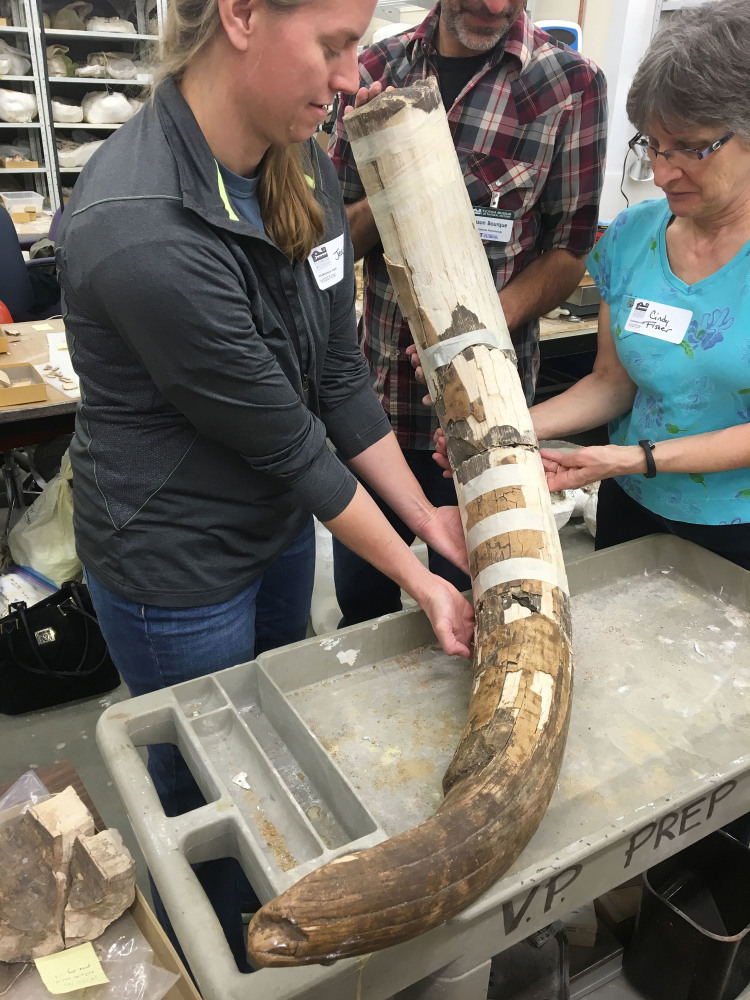Thousands of years ago, some of the first Americans knelt beside a pond in what is now Florida. Clutching sharp stone knives, they hacked at the tusk of a slain mastodon, slicing meat away from the long bone. Then, with their work completed, they got up and walked away, leaving behind some tools and the stripped carcass.
Centuries passed. Sea levels rose. The ancient site was submerged by layers of sediment, and then by a rising river. Wave after wave of human inhabitants came and went: hunters, farmers, explorers, colonizers, retirees from New York. Until, in 2012, a team of archaeologists descended into the river’s murky depths to dig up the artifacts below.
ANCIENT HUMAN REMNANTS
The ancient tools and bone are 14,550 years old, the archaeologists reported Friday in the journal Science Advances, making them the most ancient human remnants ever found in the southeastern United States. The researchers say the find is unequivocal proof that people were in Florida more than 1,000 years earlier than anyone had imagined – a discovery that could help rewrite the history of humans on the continent.
The new study comes as something of a vindication for the swampy site in the Florida panhandle, named Page-Ladson for the diver who discovered it and the family whose land it is on. In the 1980s, archaeologist James Dunbar and paleontologist David Webb dug up the knife-scarred mastodon tusk that had been left there and estimated it to be more than 14,400 years old.
But the anthropological community was quick to cast doubt on that date. For half a century it had been assumed that the Clovis people – skilled hunters famous for their distinctive fluted spear points – were the first to migrate from Asia and then down through Canada after the glaciers began to melt at the end of the last ice age, roughly 13,000 years ago.
The age given for the tusk didn’t fit that paradigm, other scientists said – the ice-free corridor wouldn’t even have been open yet. Something must have gone wrong with the dig or the radiocarbon dating, or perhaps the marks on the tusk were caused by something other than a human. Even Dunbar and Webb expressed some misgivings about their results.
“I always felt that Dunbar and Webb had been kind of maligned,” said Mike Waters, the director of the Center for the Study of the First Americans at Texas A&M and a principal investigator on the latest Page-Ladson report. “So when I was given the chance to go back there, I jumped at it.”
This time, Waters and his colleagues were armed with dating techniques orders of magnitude more precise than their predecessors’. They also had an increasingly compelling case for “pre-Clovis” occupation of the Americas: genetic analyses showing that Native Americans’ ancestors arrived here some 16,000 years ago and archaeological sites as far-flung as Oregon and Chile bearing evidence of human presence long before Clovis.
“What we tried to do at Page-Ladson is make a really strong case that would be unassailable … that these artifacts are man-made and they’re exactly where those people left them 14,550 years ago,” Waters said.
A ‘CHRONOLOGICAL LAYER CAKE’
The project involved years of painstaking excavation in the Aucilla River, a slow-moving, coffee-colored waterway shaded by cypress trees and inhabited by alligators. Underwater archaeologists dug up and dated layer after layer of sediment from the river bottom, sifting through each patch of dirt for evidence that humans had once been there.
They uncovered what co-author Tom Stafford calls a “chronological layer cake.” More than 70 samples of ancient organic material taken from the site and radiocarbon dated at Stafford’s lab showed that each layer was slightly older than the one before it. They prove that nothing had disturbed or mixed up the sediments as they were laid down over time.
By the time archaeologists reached the 14,500-year-old stratum, they began to find objects they say could only have come from humans: five sharpened rocks that were carried in from elsewhere in the region, and a double-sided stone knife, or biface, that would have been among the most advanced technologies of the time. The team then re-examined the mastodon tusk found by Webb and Dunbar (who was also part of this excavation) and determined that it was most likely butchered by humans.
“It’s really exciting,” said Jessi Halligan, an archaeologist at Florida State University and Waters’s fellow principal investigator. “We have these unambiguous cultural artifacts found in an intact geological stratum that dates to more than 1,500 years older than Clovis. That’s why it’s a big deal. That’s why we have to revisit our theory for how the Americas were colonized.”
Copy the Story LinkSend questions/comments to the editors.



Success. Please wait for the page to reload. If the page does not reload within 5 seconds, please refresh the page.
Enter your email and password to access comments.
Hi, to comment on stories you must . This profile is in addition to your subscription and website login.
Already have a commenting profile? .
Invalid username/password.
Please check your email to confirm and complete your registration.
Only subscribers are eligible to post comments. Please subscribe or login first for digital access. Here’s why.
Use the form below to reset your password. When you've submitted your account email, we will send an email with a reset code.